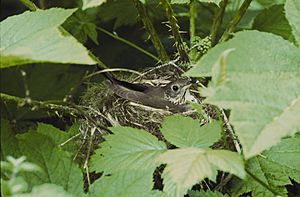Grey-cheeked thrush facts for kids
The Grey-cheeked Thrush (Catharus minimus) is a medium-sized thrush bird. It measures about 15 to 17 centimeters long. This bird is known for a special white-dark-white pattern under its wings. It belongs to a group of birds that travel long distances, like the Veery and Bicknell's Thrush. The Grey-cheeked Thrush looks very much like the Bicknell's Thrush. You can mostly tell them apart by their slightly different size and their unique songs. These two birds used to be thought of as the same species. Among all the spotted thrushes in America, the Grey-cheeked Thrush breeds the farthest north.
Quick facts for kids Grey-cheeked thrush |
|
|---|---|
 |
|
| Conservation status | |
| Scientific classification | |
| Genus: |
Catharus
|
| Species: |
minimus
|
 |
|
| Synonyms | |
|
Hylocichla aliciae |
|
Contents
Description
The Grey-cheeked Thrush is a bit bigger than other thrushes in its group. It is about 16 to 17 centimeters tall and weighs between 26 and 30 grams. Its wings can spread out to about 32 to 34 centimeters.
You can spot this bird by its grayish face and a light ring around its eye. Its upper body is a dull gray-brown, and its sides are quite dark. The area between its eye and beak is grayish, but the part from its beak to above its eye is grayish white. The Grey-cheeked Thrush looks almost exactly like the Bicknell's Thrush.
There are two types, or subspecies, of the Grey-cheeked Thrush. One is the northern Grey-cheeked Thrush (Catharus minimus alicia). The other is the Newfoundland Grey-cheeked Thrush (Catharus minimus minimus). The Newfoundland type is browner overall and has a more buff color on its chest. It also has a brighter yellow area at the base of its lower beak. The northern type has grayish-olive upper parts and sides. Its chest is a light cream color, and its lower beak is duller.
Taxonomy
The Grey-cheeked Thrush is very closely related to the Bicknell's Thrush (Catharus bicknelli). They look almost identical. These two species separated from each other very recently. This means there are only small genetic differences between them. Dr. Henri Ouellet was the first to suggest that the Bicknell's and Grey-cheeked thrushes should be considered separate species in 1996.
Habitat and Distribution
The Grey-cheeked Thrush travels very long distances. On average, they migrate about 300 kilometers. They are thought to spend their winters in the Amazon basin. During their spring migration, they fly across the Caribbean Sea and the Gulf of Mexico.
These birds are found in their breeding areas from May to August. Their breeding grounds include the northern boreal forests. These stretch from Newfoundland to Alaska in North America. They also cross the Bering Sea to Eastern Siberia. They like dense conifer and broadleaf shrub thickets. While not common in most parts of North America, you might see C. minimus in any wooded area. Their breeding range goes north of the treeline into low Arctic willow and alder beds.
Grey-cheeked thrushes prefer low coniferous woods. This includes young, growing forests. They also like old forests with open canopies that have thick shrubs and small conifers underneath. They can also be found in dense, stunted spruce and fir trees in windy spots and near the tree line.
The two subspecies also have different breeding ranges. Catharus m. alicia breeds from Labrador west to Siberia. Catharus m. minimus breeds on the island of Newfoundland. It might also breed in nearby parts of southern coastal Labrador.
Behavior
Vocalizations
The best way to tell a Grey-cheeked Thrush apart from a Bicknell's Thrush is by its calls. Its song is complex, with burry, flute-like notes. These notes usually go downwards at the end. It sounds like a descending spiral, similar to the Veery (Catharus fuscescens). However, it is higher, thinner, and more nasal, with short pauses. It sounds like: "ch-ch zreeew zi-zi-zreeee zizreeew".
Its flight call is a high, strong, nasal "queer". You are more likely to hear its call at night during spring and fall migration. This is more common than seeing the bird on the ground. The night flight note is a one or two-note "whe-eer" that drops in pitch.
Diet
The Grey-cheeked Thrush (C. minimus) mainly eats insects. These include beetles, weevils, ants, wasps, and caterpillars. They also eat arachnids, which are like spiders. Besides insects, they enjoy fruits and berries, such as wild cherries, blackberries, and raspberries. They also feed on crayfish, sow bugs, and earthworms.
When they eat berries, they help to spread seeds. This is called seed dispersal.
Reproduction
During the breeding season, Grey-cheeked Thrushes are quite shy. You won't often find many nesting pairs close together. This is because their territories are spread out. They build their nests on the ground or in low shrubs. These nests are usually less than 2 meters high.
The female bird builds the nest. She uses dried grasses mixed with a layer of mud to make it strong. They usually have only one group of young (brood) per season. However, if their first nest fails early, they might lay a second set of eggs.
A nest usually has 4 eggs, but it can be anywhere from 3 to 5 eggs. The female sits on the eggs for 13 to 14 days to keep them warm. The eggs are greenish-blue with light brown dots. They are oval or short oval in shape. The young birds leave the nest (fledge) 11 to 13 days after hatching. Both parents take care of the young birds. These birds can start breeding when they are one year old. They are believed to stay with the same partner for life.
Images for kids
See also
 In Spanish: Zorzalito carigrís para niños
In Spanish: Zorzalito carigrís para niños



